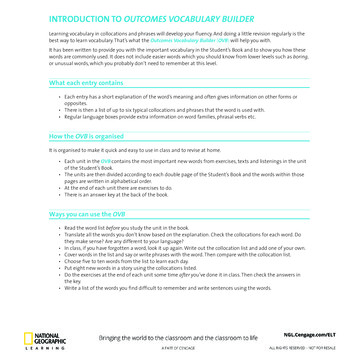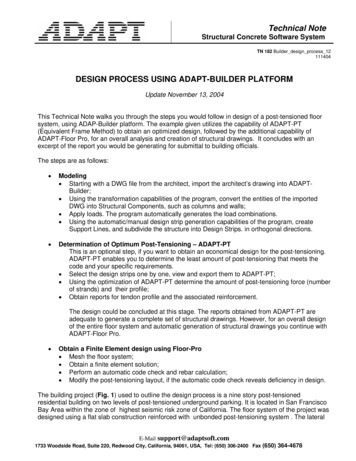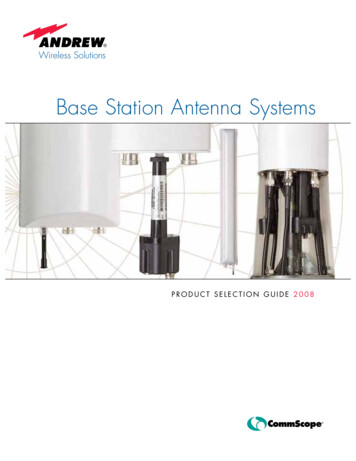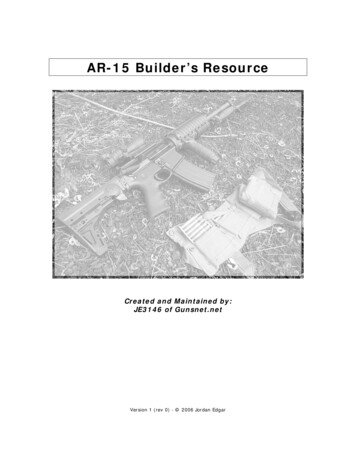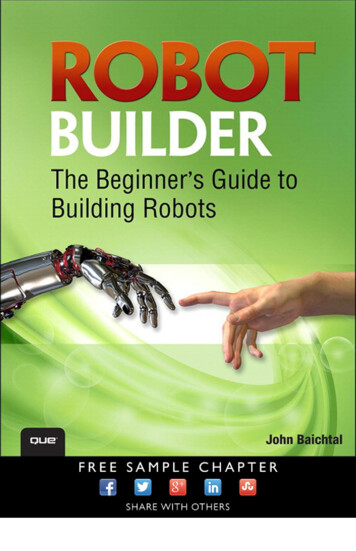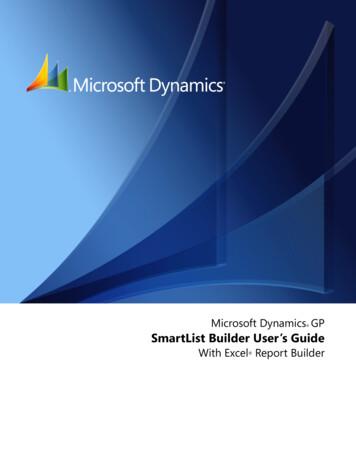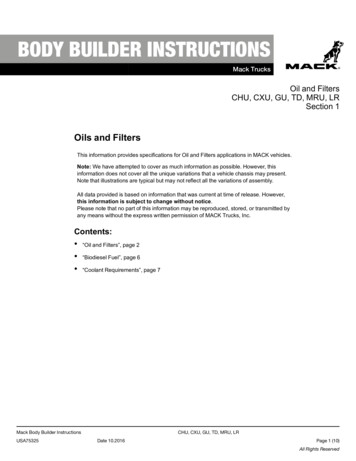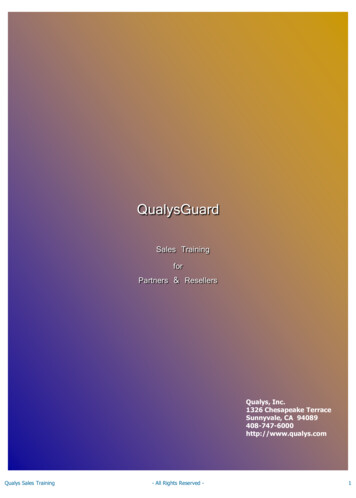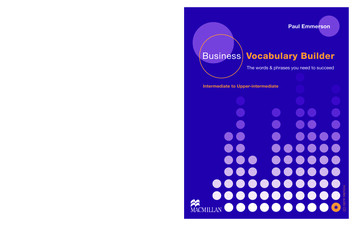
Transcription
Business Vocabulary Builder is a business vocabulary and practicecourse for students with an intermediate level of English or above.Using the course will enrich your business vocabulary and enable you toexpress yourself more fluently and confidently in a professional context.The accompanying Audio CD provides essential listening practiceand extension exercise and features real, international business peoplefrom a wide range of backgrounds. (The complete tapescriptis contained in the book.)A1 A2 B1 B2 C1 C2www.macmillanenglish.com9780230716827 BVB NEW cover.indd 1MacmillanEssential Dictionary9780230 716841The words & phrases you need to succeedIntermediate to Upper-intermediateincludes audio CDI S B N 978-0-230-71684-1Paul EmmersonCOMMON EUROPEAN FRAMEWORKBusiness Vocabulary BuilderIntermediate to Upper-intermediateThe vocabulary is organized by business topic (first part) and businessskill (second part), making it simple for you to target the language andskills you need. The imaginative variety of practice exercises makesthe vocabulary easier to digest and remember. The topics and skills arecovered from a 21st-century perspective, teaching up-to-date languagein modern business contexts.Business Vocabulary BuilderBusiness Vocabulary BuilderPaul Emmerson21/11/08 11:40:44
ContentsBUSINESS TO PI CSFinancial marketsThe business world31 Financial markets6632 Investing in stocks681The economy62The business cycle83International trade104Setting up and growing a business125Company types and corporate governance146Global issues for the 21st century16Human resources33 Recruitment7034 Pay and benefits7235 Issues in the workplace74E F F E C T IV E C O M M U N IC AT IO NManagement7Management styles and qualities188Organizing time and work209Planning and setting objectives2210 Leading and motivating2411 Insurance and risk management26Production and operations12 Manufacturing and engineering2813 Inside a factory3014 Procurement and purchasing3215 Supply chain management and logistics3416 Lean production3617 Quality38You and your job36 Your background and career7637 Your company7838 Your job80Telephoning39 Telephoning – making and taking calls8240 Telephoning – messages8441 Telephoning – checking, clarifying, activelistening8642 Telephoning – arranging a meeting8843 Telephoning – complaints9044 Telephoning – review92EmailsSales and marketing45 Emails – basics9446 Emails – internal communication9647 Emails – commercial9818 Sales4019 Customer service4220 Markets and marketing4421 Product4622 Distribution (place)4823 Promotion5024 Price52Presentations25 Marketing management5451 Presentations – opening10652 Presentations – main body10853 Presentations – closing and questions11054 Presentations – trends I11255 Presentations – trends II11456 Presentations – review116Company finance26 Income statement5627 Balance sheet5828 Cash flow statement6029 Managing cash flow6230 Profitability6448 Emails – customer issues10049 Emails – arranging a visit10250 Emails – review10449780230716827 P001-029.indd 420/11/08 12:15:06
MeetingsL IS T E N IN G scripts57 Meetings – opinions118Listen and repeat exercises15658 Meetings – making things clear120Interviews with business people15759 Meetings – problem-solving12260 Meetings – leading a meeting124ANSWER KEY16461 Meetings – negotiating I12662 Meetings – negotiating II12863 Meetings – diplomatic language13064 Meetings – review132Business reports and proposals65 Business reports and proposals – reports I13466 Business reports and proposals – reports II13667 Business reports and proposals – proposals I 13868 Business reports and proposals – proposals II 14069 Business reports and proposals –142linking words70 Business reports and proposals – review144SPEAKING PRA CTI CEDiscussion topics146WRITING PRA CTI CEWriting tasks151LIST ENING PRA CTI CEInterviews with business people: exercises1Interview with a private equity investor1532Interview with an entrepreneur1533Interview with a management trainee1534Interview with a supply chain manager1535Interview with a sales manager1546Interview with a marketing director1547Interview with a finance director1548Interview with a human resources director15559780230716827 P001-029.indd 520/11/08 12:15:06
15Supply chain management and logisticsWhat is the supply chain?The supply chain is the flow of parts and raw materials fromtheir point of origin to the factory gates, then through thefactory as work-in-process, and finally out of the factory asfinished goods to be delivered to the final customer.A modern manufacturing operation might have hundredsof suppliers providing different parts and components, andeach of these suppliers will in turn have their own suppliersproviding simpler parts, raw materials, etc. This is theupstream end of the supply chain. Similarly, the downstreamend of the chain might consist of distributors, multiplecustomers, etc, and will involve batches of goods beingshipped at different times to different places.Supply chain managementDuring the whole process, from beginning to end, inventory(ie parts and goods) needs to be stored in warehousesand distribution centres and then transported as needed.All of this involves a huge amount of computerizedinformation about the location of inventory, its expectedarrival time at the next point, etc. This information has to beshared across many different companies and IT networks:suppliers, customers, third party logistics providers and themanufacturer itself. The management of this information iscritical to the success of the business.The complexity of logistics t involves both inbound and* Ioutboundgoods.So, supply chain management (SCM) makes sure that theright items are in the right place at the right time and in theright quantities. There are of course wider strategic issues: How many suppliers should there be? And where? Where should the production facilities, distributioncentres and warehouses be located? What distribution channels should be used? Which logistics companies should be used, both upstreamand downstream? How can IT be used to integrate all the processes, makethem more efficient, flag up potential bottlenecks, giveclear signals of demand downstream, etc? How is cash flow and payment to all the parties involvedin the supply chain going to be managed?The aim of SCM is to collaborate with all the supply chainpartners to improve the visibility and velocity of inventory.LogisticsThe word ‘logistics’ refers to the practical issues surroundingtransportation, warehousing and inventory management.Where there is an external focus it’s more or less asynonym for SCM, but it can also have an internal focus,getting materials from site A to site B inside a company atdifferent stages of the business process. The term ‘logistics’is also used in smaller companies where ‘supply chainmanagement’ seems too grand.t involves materials handling inside the factory: goods are* Iplacedon pallets and moved around on fork-lift trucks.t involves inventory management at every stage using IT.* IThisincludes the ability to track items in transit.t includes reverse logistics (ie,* Iwhengoods are returned to thet involves co-ordination with related business functions* Isuchas purchasing and plant management.manufacturer, either because ofcustomer returns, or overstockedinventory at the retailers, or outdatedmerchandise that can no longer sell).t involves a choice of means of transport: air (using special* Icargoairlines); sea (with containers stacked up on top oft involves unloading items from one means of transport* Iandloading onto another. This can be at a distributioncentre or a warehouse. There are three possibilities:Hub and spokeConsolidationDeconsolidationMaterials arebrought in to onecentral locationand then sorted fordelivery to a varietyof destinations.A variety of smallershipments arecombined into onelarger shipmentfor economy oftransport.Large shipments arebroken down intosmaller lots for easeof delivery.each other); road (vans, or trucks with trailers); rail (usingwagons / freight cars).t involves a decision whether or not to use a third* Ipartylogistics provider (3PL). These companies provideintegrated pick-and-pack, warehousing and distribution.They can also act as forwarding agents to handle shippingarrangements.349780230716827 P030-053.indd 3420/11/08 12:15:49
15 suPPLy chaIn managEmEnt and LogIstIcsExercises15.1 Find a word in the text opposite that matches eachdefinition below. The words appear in order.1 at an earlier stage in a process2 at a later stage in a process3 groups of things that are made (or dealt with) together15.4 Complete the text about logistics using the wordsin the handlingselectingwarehousing4 large buildings for storing goods5 (two words) buildings used for the storage of goods whichwill later be shipped to retail outlets6 (four words) external firms that provide specialistservices such as transportation and warehousing‘Logistics’ is a term that is used in many different ways.Using a broad definition it can include all of the following:7 (phrasal verb) draw attention to somethingDemand 2and planningDetermining the quantity of goods that need to be orderedin the future.8 delays in one stage of a process that make the wholeprocess take longerNow do the same for the words in ‘The complexity oflogistics’ opposite.9 coming towards or arriving at (eg a factory or airport)10 (formal) goods for sale11 taking goods off a vehicle12 (three words) the design of the inner part of awheel, with a central part and lines coming out of it13 flat wooden structures used for moving or storing heavygoods14 (two words) vehicles with special equipment at the frontfor lifting and moving heavy objects15 follow the progress of16 (phrasal verb) arranged into a neat pile17 back sections of trucks that can be separated, and areused for carrying heavy objects18 process of starting with a large quantity of goods,sorting them according to different destinations, andthen re-packaging them with new shipping labels15.2 Read the definitions and complete the exampleswith one of these words: cargo, freight.1 goods carried by ship or aircraft [ of]Example: a ship carrying aof oil2 goods carried by ship, train or aircraft; the system of movingthese goodsExample:servicesCustomer service1the right product is at the right placeat the right time.Inventory management and materials 3Keeping the supply chain flowing, with no bottlenecks, by4the quantity of items at differentlocations and different stages in the process.Communication technologythe organization to its supplierswith IT, for example to provide information about demandpatterns to facilitate Just-In-Time delivery.5Transportation6the best means of transportation(ie air, rail, ship, truck).Purchasing7with suppliers about price, availability,quality, etc.8Locating and designing facilities that allow efficient storageand distribution.All the above activities must be coordinated properly.Inevitably there will be trade-offs – less of one thing andmore of something else – in order to achieve the bestoutcome overall.See page 147 for some discussion topics.15.3 Make phrases by matching an item from eachcolumn.1 supplyprovider2 finishedcustomer3 finalchain4 logisticsagent5 distributiongoods6 forwardingchannelProduction and operations9780230716827 P030-053.indd 353520/11/08 12:15:50
18salesWhat sales thinks about marketing!Sales consultants will quickly tell you how their job isdifferent to marketing. They’re the ones who have directcontact with the customers, they’re the ones who reallyknow what is going on in the market, and of course they’rethe ones who live with the insecurity of sales targets andcommissions. The marketing guys just sit in their offices onfixed salaries, dreaming up fancy promotions, or thinking ofnew products that later research will tell them no-one wants.If only the marketing guys spoke to the sales guys moreoften, the business would do so much better.What qualities does a salesperson need?A salesperson needs to be: Knowledgeable (of the customer and their needs, of theproducts being sold, and of the industry and technical area). Visibly well prepared, organized and well-presented toinspire confidence in the other person. Reliable (eg they phone back when they say they will). Flexible (eg they’re able to respond to changing customerneeds and offer tailor-made solutions).It is an old-fashioned cliché to think of a modern salesconsultant as behaving like someone who sells second-handcars. These days an aggressive hard sell very rarely works.Customers want to be helped to make their own decisions,not to be pushed before they’re ready. The box below givessome ideas for modern sales techniques.There are a variety of methods to close the deal: a directrequest, a command, a reference to an immediate gain, fear,presenting alternatives, a summary, and finally simply anassumption that the customer is going to buy (ie behaving asif it’s true even though the customer hasn’t actually said yes). Sales techniquesGeneral pointsTry to identify the different roles inside a company. Who isthe decision maker? Whose advice will they listen to? Whowill actually be using the product?Take time to socialize and build rapport in the first fewmoments. In particular, show interest in the customer.Discovering customer needsHave ‘big ears and a small mouth’. Ask lots of questions.Listen actively: focus your attention on the other personand take notes. Knowledge of customer needs is a majorcompetitive advantage – just as important as the productfeatures or the price.Check needs by restating them.Refer to the information you have collected throughout therest of the meeting.Presenting the best caseBuild a case slowly, based on the individual customer’sneeds, rather than working from a script.Be clear and precise, judge the level of detail required, andavoid jargon.Emphasize benefits (ie what a product does – how it willmak
Business Vocabulary Builder Paul Emmerson Business Vocabulary Builder is a business vocabulary and practice course for students with an intermediate level of English or above. Using the course will enrich your business vocabulary and enable you to express yourself more uently and con dently in a professional context. The vocabulary is organized by business topic ( rst part) and business
